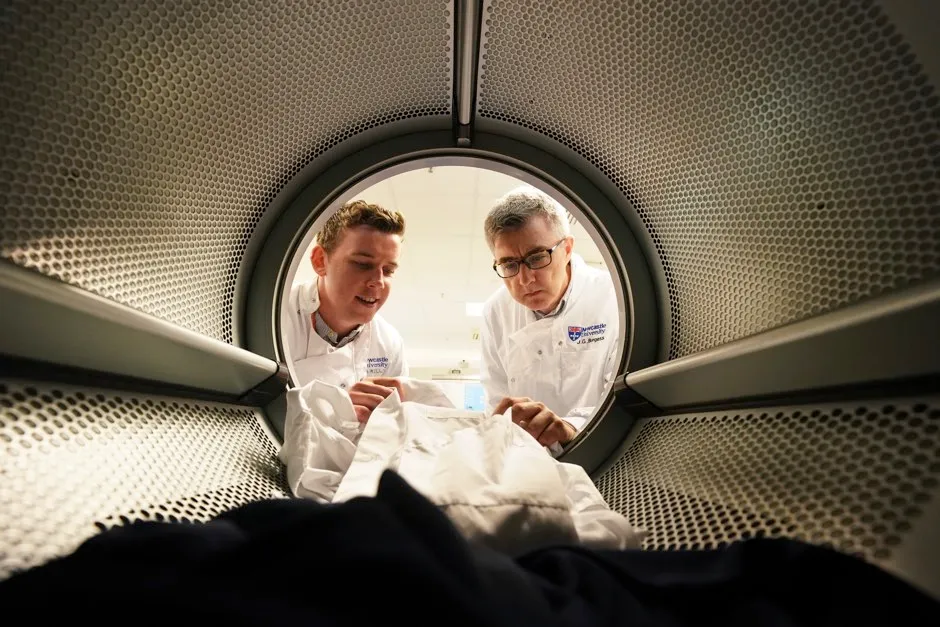Wrongly using a delicate cycle for everyday laundry is causing hundreds of thousands of extra microfibres to be released into our water systems and end up in the sea, scientists have found.
Although regular washing cycles cause clothes to be bashed together and create more friction between garments, they use less water than gentler programmes which agitate the garments less, they said.
Read more about plastic pollution:
- Has Blue Planet II had an impact on plastic pollution?
- Plastic waste: how can I reduce the amount that ends up in landfill?
Researchers at Newcastle University found that it is the volume of water used, rather than the spinning action in the drum, which is the key factor in plucking the tiny plastic particles from man-made material.
Millions of plastic microfibres are shed every time we wash clothes that contain materials such as nylon, polyester and acrylic.Because these fibres are so small, they drain out of the back of the washing machine and can ultimately enter the marine environment, where they can be ingested by tiny animals and end up in our food chain.

Two years ago, Newcastle University scientists showed for the first time these fibres have now reached the deepest parts of our ocean.
PhD student Max Kelly, working with Procter & Gamble’s Newcastle lab, measured the release of microfibres from polyester clothes from a range of different cycles, temperatures and water volumes.Counting the fibres released, they found the higher the volume of water the more fibres released, regardless of the speed and abrasive forces of the washing machine.
Using a hi-tech camera, they counted 1.4 million fibres from a delicate wash of a polyester garment, 800,000 when a normal cotton wash was used and 600,000 from a cold express programme.
How does plastic get into the oceans?
Asked by: Tamsin Nicholson, via email
Around 80 per cent of the plastic waste found in the oceans today originated inland. Littering, poor waste management and industrial activity can all allow plastic to enter the natural environment.
A significant proportion of this then blows into rivers and streams, which carry it into the ocean. This is particularly common in countries where waste infrastructure is lacking: an estimated two billion people worldwide don’t have access to solid waste collection.
On top of this, wastewater from our homes often contains tiny pieces of plastic, including microbeads from cosmetics (now banned in the UK) and fibres from polyester clothing. Tackling plastic pollution therefore requires individuals, governments and companies across the globe to work together to reduce plastic consumption and waste.
Read more:
- Does the plastic debris found in bottled water affect our bodies?
- Why are some plastics recyclable and others are not?
Follow @sciencefocusQAon Twitter for your daily dose of fun facts, and send your questions to questions@sciencefocus.com.
Mr Kelly said: “Counter-intuitively, we discovered that ‘delicate’ cycles release more plastic microfibres into the water, and then the environment, than standard cycles.
“Previous research has suggested the speed the drum spins at, the number of times it changes spinning direction during a cycle and the length of pauses in the cycle – all known as the machine agitation – is the most important factor in the amount of microfibre released.
“But we have shown here that even at reduced levels of agitation, microfibre release is still greatest with higher water volume-to-fabric ratios. This is because the high volume of water used in a delicate cycle which is supposed to protect sensitive clothing from damage actually ‘plucks’ away more fibres from the material.”
Consumers should make sure they are using the correct cycle for their laundry and avoid washing half loads so there is not a high volume of water to garments.
Dr Neil Lant, a research fellow at P&G who worked on the project, said: “People thought quite intuitively that a delicate wash cycle would reduce loss of fibres because the fibres are rubbing against each other less.”He said garments from natural fibres such as wool or silk should still be washed on a delicate programme.
Washing machine manufacturers have developed microfibre filters to catch the mini-pollutants before they are released into the water system while the textile industry has worked on reducing fibre shedding.
Marine microbiologist Professor Grant Burgess said it was thought the microfibres can clog the digestive systems of the tiny animals that ingest them.
He added: “Some of these fibres can attract pollutants and toxic chemicals which stick on to the fibres. They can act as concentrators of other toxic pollutants and act as a carrier of these nasty chemicals.”
The findings have been published in the journal Environmental Science and Technology.
Follow Science Focus onTwitter,Facebook, Instagramand Flipboard